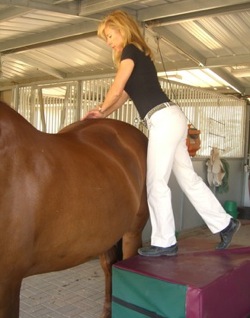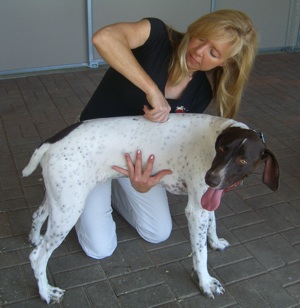Veterinary Chiropractic
What it is |
How it's used |
When it's useful |
Principles |
Chiropractor Training
 Dr. Jenny Johnson is pleased to announce the addition of veterinary chiropractic services to her practice. Dr. Johnson has completed 210 hours of postgraduate training in animal chiropractic at the Options for Animals program in Wellsville, Kansas. This training has included extensive lecture and practical hands-on training in the chiropractic care of horses and dogs. Dr. Johnson has successfully completed rigorous practical, clinical competancy, and written exams and has earned certification in Veterinary Chiropractic by the International Veterinary Chiropractic Association.
Dr. Jenny Johnson is pleased to announce the addition of veterinary chiropractic services to her practice. Dr. Johnson has completed 210 hours of postgraduate training in animal chiropractic at the Options for Animals program in Wellsville, Kansas. This training has included extensive lecture and practical hands-on training in the chiropractic care of horses and dogs. Dr. Johnson has successfully completed rigorous practical, clinical competancy, and written exams and has earned certification in Veterinary Chiropractic by the International Veterinary Chiropractic Association.
WHAT IS VETERINARY CHIROPRACTIC?
Veterinary chiropractic is a holistic branch of veterinary medicine that focuses on the health and functioning of the nervous system. The nervous system controls all of the functions of the body including the motor and sensory functions as well as the functions of the organs of the body. The bony vertebral column has an intimate relationship with the nervous system in that it houses the spinal cord. If the joints of the vertebral column do not move as they should, this will affect the nerves that enter and leave the spinal cord. These nerves transfer information between the brain, spinal cord, organs, muscles, and other parts of the body. Muscle spasm or inflammation near a vertebral joint can cause a reduction in the normal range of motion of that joint. In chiropractic terminology, this is called a vertebral subluxation complex. This can affect the information that is being carried to the brain by the nerves that enter the spinal cord at this site, and this, in turn, can lead to interference in the flow of stimuli or information between the brain and the body. It is important that these nerve fibers function normally in order for there to be smooth coordination of body functions and muscle contractions.
Veterinary chiropractic focuses on the relationship between structure (primarily the spine) and function (as coordinated by the nervous system) and how that relationship affects the preservation and restoration of health in animals. The discipline of chiropractic emphasizes the inherent recuperative power of the body to heal itself without the use of drugs or surgery.
Chiropractic care is not a replacement for traditional medical and surgical techniques but can be an important adjunct in the care of the animal as a whole. It can be used for chronic as well as acute problems. With chronic conditions, chiropractic treatment can support recovery and prevent secondary problems due to altered biomechanics of the skeleton. Increasing the quality of life or health is especially important when treating older animals, but chiropractic treatment of younger animals is also recommended as a preventive measure. Chiropractic treats the cause, not the symptoms of back problems. It restores joint mobility enabling the animal to maximize its performance potential.
HOW IS CHIROPRACTIC CARE USED IN ANIMALS AT OAKHILL?
The treatment procedures utilized by Dr. Johnson in the practice of animal chiropractic include the adjustment of vertebrae, the adjustment of the extremities and the adjustment of cranial sutures. Dr. Johnson will frequently include management advice as to what is needed to insure proper response to chiropractic care.
Dr. Johnson will take a thorough case history, including information from the owner about the animal’s occupation and exercise schedule, information obtained from previous veterinary examinations, radiographs or laboratory analysis, as well as previous diagnoses and therapies.
After obtaining a history on the animal, Dr. Johnson will examine the animal. The examinations performed include, but are not limited to: posture analysis, gait analysis, evaluation for areas of increased temperature or heat, vertebral, extremity and cranial static palpation, vertebral and extremity motion palpation, short leg analysis, orthopedic evaluation and neurological evaluation.
The information from the case history and examination are combined to determine a working diagnosis. Dr. Johnson will then formulate a therapeutic plan and proceed with treatment, which will include adjusting vertebral subluxation complexes, adjusting subluxation complexes in the extremities, and/or referring the patient back to his primary care veterinarian for further examination or care.
Dr. Johnson works closely with your regular veterinarian to insure that your animal receives complete integrative health care.
WHEN IS CHIROPRACTIC CARE USEFUL IN ANIMALS?
The purpose of chiropractic care is to optimize health. As such, all animals could benefit from regular chiropractic care.
While chiropractic care is commonly associated with primary disorders of the back and neck, its usefulness is not limited to these areas. In that the nervous system controls every function of the body, it is easy to see that a disruption to some portion of the nervous system could have an adverse affect in many areas. The spinal nerves exit the spinal column at each vertebral joint. These nerves innervate every structure in the body, including the internal organs. If there is a decreased range of motion at the vertebral joint where the nerve exits the spinal canal, it is likely that there may be accompanying inflammation and muscle spasm. This will affect the transmission of nerve signals between the body and the brain. This can lead to significant dysfunction either in the animal’s motor function or in the function of the animal’s internal organs. By adjusting this vertebral subluxation complex, the animal can function more normally.
Chiropractic is commonly used as an adjunct in the treatment of many lamenesses and biomechanical abnormalities. There are many cases in which the traditional lameness exam does not fully identify the source of the lameness. Frequently, chiropractic care can provide useful information and treatment for these animals. Additionally, correction of chiropractic abnormalities may help other therapies such as intra-articular injections to be more effective and to have a more long lasting result.
Similarly, there are many examples of medical conditions that do not fully respond to traditional care. Chiropractic should be considered as a treatment option in these cases. Chiropractic may be able to address a component of the problem that cannot be solved by medications alone. It is also possible that through chiropractic adjustment the body is better able to respond to the medications of traditional care.
WHAT ARE THE PRINCIPLES OF CHIROPRACTIC CARE?
The purpose of chiropractic is to optimize health. The principle that guides this is the body’s innate recuperative power which is affected by and integrated through the nervous system. The foundation of chiropractic is built on philosophy, science, art, knowledge, and clinical experience.
There are four main principles on which chiropractic is based:
1. The nervous system controls everything
in the body
2. The spinal column serves to support and
protect the spinal cord
3. A reduction in the ability of the spinal
column to properly function and move may
have an adverse affecton the spinal cord and
the central nervous system.
4. Restoring the normal function and movement
of the spinal column may have a positive influence
on the function of the nervous system.
The animal chiropractor treats vertebral subluxation complexes through adustments. A vertebral subluxation complex is the situation that arises when two adjacent articulating structures (2 bones in a joint) have an abnormal relationship (typically a reduction or absence of the normal range of motion). This abnormal relationship may lead to an alteration in the biomechanical function or neurophysiologic function of these structures and body structures that may be directly or indirectly affected by them. The vertebral subluxation complex frequently results in inflammation at the site and this may influence the neurologic signals that are being sent to the brain.
An adjustment is defined as a very specific, short lever, high velocity, controlled thrust, by hand or instrument, that is directed at specific articulations (joints) to correct vertebral subluxation complexes and/or other subluxation complexes throughout the body.
HOW IS THE ANIMAL CHIROPRACTOR TRAINED?
Veterinary or animal chiropractic is a very specific science aimed at affecting the input to the nervous system. As such, it is imperative that the individual performing the chiropractic adjustments have a thorough knowledge and understanding of anatomy and neurology as well as education in the practical aspects of achieving an effective adjustment.
It is very important that the veterinarian or chiropractor providing chiropractic care to animals is specifically trained in animal chiropractic. A veterinarian or chiropractor performing animal chiropractic should have completed a minimum of 200 hours of intensive classroom work in a program accredited by the International Veterinary Chiropractic Association or the American Veterinary Chiropractic Association. A weekend course in animal chiropractic is not adequate training! In the hands of a well educated professional with this specific training, animal chiropractic care is a very safe treatment modality.
In the state of California, under the Veterinary Practice Act, chiropractic care is considered the practice of veterinary medicine and as such, must be performed by a veterinarian trained in chiropractic. A Doctor of Chiropractic (human chiropractor) may also provide chiropractic care to animals ONLY if (1) Properly trained in animal chiropractic, AND (2) the chiropractor must work ONLY under the DIRECT supervision of a veterinarian, meaning the veterinarian is on the premises at the time the chiropractic treatment is provided. These regulations are in place to protect the health and welfare of the animals being treated. Any treatment outside these parameters is against the law and potentially injurious to the animal(s) in question.
Click these links for specific chiropractic information on: Horses | Small Animals
Want a PDF containing all the information you need on veterinary chiropractic? Download it here.